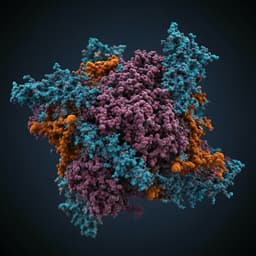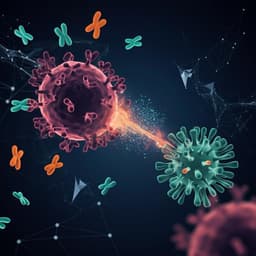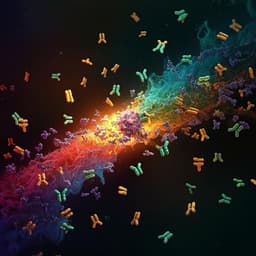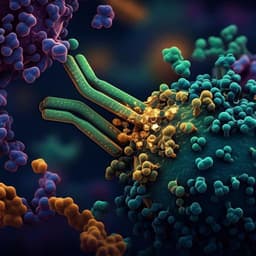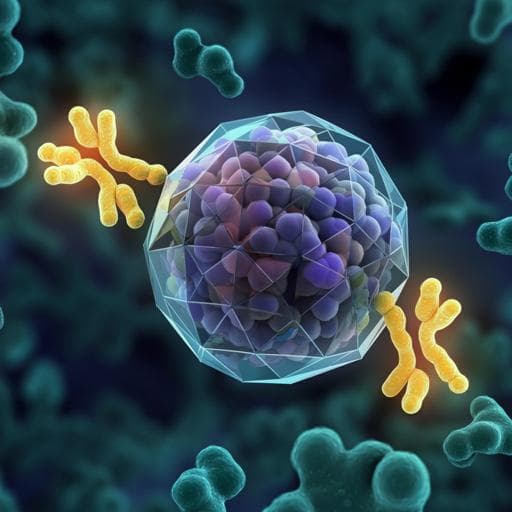
Medicine and Health
DNA origami presenting the receptor binding domain of SARS-CoV-2 elicit robust protective immune response
E. Oktay, F. Alem, et al.
This groundbreaking research by Esra Oktay, Farhang Alem, Keziah Hernandez, Michael Girgis, Christopher Green, Divita Mathur, Igor L. Medintz, Aarthi Narayanan, and Remi Veneziano reveals that DNA origami nanoparticles displaying multiple copies of a SARS-CoV-2 receptor binding domain trigger a strong immune response in mice, paving the way for innovative and effective vaccines.
~3 min • Beginner • English
Introduction
The study addresses the need for rapidly deployable, safe, and effective vaccines against SARS-CoV-2 that elicit durable protection and can be rationally designed. Current vaccine platforms (mRNA, viral vectors, protein subunits, inactivated/live-attenuated) have shown efficacy but offer limited control over antigen presentation parameters such as density, stoichiometry, and nanoscale organization. The receptor binding domain (RBD) of the SARS-CoV-2 spike protein is a key neutralizing antibody target and performs critical functions in ACE2 binding and viral entry; multivalent display (especially trimeric forms) has been shown to enhance immunogenicity compared to monomeric RBD. However, many nanoparticle systems lack the nanoscale precision to systematically modulate and study these parameters. The authors propose DNA origami nanoparticles (DNA-NPs) as a highly programmable, biocompatible platform to precisely present multiple copies of trimeric RBD and CpG adjuvant to enhance immune responses. The goal is to test whether spatially organized multivalent RBD trimers co-presented with CpG on a pentagonal bipyramid (PB) DNA origami scaffold can elicit strong and protective immunity in mice, including protection against live viral challenge and durability of humoral responses.
Literature Review
The paper surveys the vaccine landscape: mRNA vaccines (Moderna mRNA-1273, Pfizer/BioNTech BNT162b2) with >90% efficacy, viral-vector vaccines (J&J Ad26.COV2.S), and protein nanoparticle-based vaccines (Novavax) have received EUA or approval. Traditional inactivated/live-attenuated strategies are in development. Nanoparticle-based vaccines (>60 developed for SARS-CoV-2) often deliver RBD or full spike; RBD is a potent immunogen targeted by neutralizing antibodies, with trimeric presentations yielding stronger immune responses than monomers. RBD toggles between closed/open conformations to engage ACE2. Prior work shows multivalent antigen display enhances B cell receptor clustering and immune activation. Conventional NPs have limited control over antigen spatial parameters, limiting mechanistic insights and rational design. DNA origami enables design of arbitrary geometries with precise nanoscale patterning, controlled stoichiometry, and multiplexing capacity. Prior DNA-NP work (e.g., Veneziano et al. with HIV eOD-GT8) showed modulation of B cell activation by nanoscale antigen organization. DNA origami PB structures display negligible intrinsic immunogenicity, supporting specific antigen-driven responses.
Methodology
Design and construction of DNA origami PB nanoparticles: Using DAE-DALUS, the authors designed a pentagonal bipyramid (PB) DNA origami nanoparticle of theoretical diameter ~46.4 nm (52-bp edge length; sub-100 nm to favor lymphatic drainage and APC uptake). A long ssDNA scaffold was produced by asymmetric PCR and folded with 44 staple strands. Up to ten ssDNA overhangs per face (two per edge) were engineered at 3′-ends of selected staples, plus ten side overhangs if needed, using orthogonal sequences for asymmetric, multiplexed functionalization: one face for antigens (RBD trimers) and the opposite face for CpG ODN adjuvants. Correct folding and monodispersity were validated by agarose gel electrophoresis, AFM, and DLS, with an estimated folding yield of ~96%. DLS hydrodynamic diameters (Z-average ± SD): Bare PB 47.6 ± 0.61 nm (PDI 0.241 ± 0.005), PG-PB 70.7 ± 0.61 nm (PDI 0.261 ± 0.007), RBD-PB 83.6 ± 1.52 nm (PDI 0.261 ± 0.005). Measured PB diameter by DLS was 51.2 nm, consistent with design and prior reports.
Reconstitution of trimeric RBD (3-mer RBD) via Protein G-Fc strategy: A peptide nucleic acid (PNA) strand was conjugated to Cys-Protein G (Cy5-labeled PG) via maleimide chemistry, validated by SDS-PAGE and purified. PG-PNA complexes were mixed with RBD-Fc at varying ratios to form reconstituted trimeric RBD (three RBD-Fc bound to PG), verified by native and SDS-PAGE. The PNA allows high-affinity hybridization to complementary DNA overhangs on PB.
NP functionalization and characterization: PB faces were modified with complementary DNA overhangs for PG-RBD trimer attachment on one face and CpG ODNs on the opposite face via direct hybridization. AFM imaging confirmed protein attachment localized to one face for PG-PB and RBD-PB. Fluorescence-based stoichiometry: intrinsic tryptophan fluorescence indicated near-complete coverage of PG on the NP; Cy5-labeled RBD showed ~74.4% occupancy of available sites, corresponding to approximately 23 RBD domains (consistent with multimeric loading). CpG ODN loading efficiency was ~80% using fluorescein-labeled CpG and a standard curve.
Stability assay: A FRET-based assay (FAM donor/TAMRA acceptor separated by ~3 nm on non-overlapping edges) was used to monitor NP integrity in 20% mouse serum over 24 h. Bare PB exhibited ~79% decrease in fluorescence signal over 24 h, whereas PB-CpG, RBD-PB, and RBD-PB-CpG showed elevated stability across 24 h. Two-way ANOVA with Tukey’s test showed significant differences (p < 0.001).
Binding kinetics by SPR: Gold sensor chips were functionalized with biotinylated ACE2. Single-cycle kinetics assessed binding of soluble RBD-Fc monomer (2–25 nM) and PB-displayed trimeric RBD (2–25 nM equivalent RBD concentration). Determined Kd values: free RBD monomer ~4.47 nM; trimeric RBD-PB ~1.35 nM, indicating enhanced apparent affinity/avidity on NP. Association/dissociation constants were reported and comparable to literature ranges.
Immunization and challenge studies in mice: BALB/c mice were immunized intramuscularly with two doses (50 µL each) of various constructs at a 3-week interval: PB, PB-CpG, RBD-PB (1 µg RBD), RBD-PB (5 µg RBD), and RBD-PB-CpG (1 µg RBD) along with multiple control groups (PBS; free RBD; RBD + CpG unconjugated; and RBD + CpG with Alhydrogel). Serum collected at Week 6 was evaluated for neutralizing activity by plaque reduction neutralization test (PRNT) and antibody titers by ELISA. For protection studies, K18-ACE2 transgenic mice received the same immunization regimens and were challenged intranasally with live SARS-CoV-2 (Isolate Italy, 5 × 10^4 PFU/mouse). Survival and body weight were monitored for 14 days post-challenge. Durability was assessed by collecting sera 2 months after the second dose for neutralization and ELISA (IgG, IgM, IgA). Ethics: IACUC protocol #0399 at GMU.
Key Findings
- DNA origami PB nanoparticles were successfully constructed with high yield (~96%) and appropriate size (DLS ~51.2 nm; Z-averages: Bare PB 47.6 nm; PG-PB 70.7 nm; RBD-PB 83.6 nm; PDIs ~0.24–0.26), and could asymmetrically display biomolecules on opposing faces.
- Efficient antigen/adjuvant loading: near-complete PG coverage; ~74.4% of RBD sites occupied (approx. 23 RBD domains), and ~80% CpG hybridization yield.
- Serum stability: In 20% mouse serum over 24 h, bare PB signal decreased ~79%, whereas PB-CpG, RBD-PB, and RBD-PB-CpG showed markedly improved stability (two-way ANOVA p < 0.001).
- Binding kinetics: SPR showed enhanced apparent binding for trimeric RBD displayed on PB (Kd ~1.35 nM) versus soluble RBD-Fc monomer (Kd ~4.47 nM), with consistent ACE2 immobilization (mean ~1540 RU).
- Immunogenicity and neutralization: Two-dose immunization elicited significant virus neutralization in sera from RBD-PB (1 µg and 5 µg) and RBD-PB-CpG (1 µg) groups versus controls (statistical significance reported, p < 0.001 in assays presented).
- Protection in vivo: After intranasal SARS-CoV-2 challenge (5 × 10^4 PFU), the RBD-PB-CpG (1 µg) group exhibited 0% mortality and no body weight loss over 14 days. The RBD-PB (5 µg) group showed ~60% survival (40% mortality) at Day 14. Bare PB and PB-CpG groups each had only two survivors (40% survival). Control groups generally had higher mortality; among controls, 3-mer RBD (1 µg) + CpG with Alhydrogel achieved the highest survival (60%). Weight loss comparisons by two-way ANOVA were significant (p < 0.001).
- Durability: At 2 months post-boost, mice immunized with RBD-PB-CpG (1 µg) retained significant neutralization versus PBS (p < 0.001), with measurable RBD-specific IgG, IgM, and IgA by ELISA (no significant differences among the mean concentrations of these isotypes by Tukey’s test, p > 0.05).
Discussion
The findings demonstrate that precise nanoscale presentation of trimeric SARS-CoV-2 RBD together with CpG adjuvants on DNA origami PB nanoparticles enhances both antigen stability and functional avidity for ACE2, translating into strong humoral responses, significant neutralization, and protection against live viral challenge in mice. The improved apparent affinity (lower Kd) for PB-displayed trimeric RBD likely reflects multivalency and efficient receptor engagement, while co-presentation of CpG augments immune activation. Notably, robust protection was achieved even with a low antigen dose (1 µg) when CpG was co-presented, eliminating mortality and preventing weight loss post-challenge. The nanostructure’s programmable geometry allows controlled stoichiometry and spatial organization, enabling optimization of antigen density and co-localized adjuvant delivery, which appear critical for maximizing immune responses. These results support DNA origami as a rational vaccine design platform capable of reducing antigen doses while maintaining efficacy and providing durable humoral immunity.
Conclusion
This work introduces a programmable DNA origami PB nanoparticle vaccine that displays ten trimeric SARS-CoV-2 RBDs and ten CpG ODN adjuvants on opposing faces, achieving enhanced stability, improved ACE2-binding avidity, potent neutralization, and protective efficacy in mice, including sustained antibody responses 2 months post-boost. The approach underscores the importance of antigen spatial organization and multivalency, and suggests that co-presentation of adjuvants can substantially reduce required antigen dose and cost per dose. DNA origami’s flexibility and multiplexing capacity may enable broad-spectrum vaccines targeting multiple antigens or variants. Future work should focus on scaling ssDNA scaffold production, optimizing particle manufacturing, exploring variant cross-protection, and advancing toward translational studies.
Limitations
- Manufacturing and scalability: Large-scale, cost-effective production of long ssDNA scaffolds remains a challenge, and further process optimization is needed to reduce production costs and streamline particle fabrication.
- Model system: Efficacy and protection were demonstrated in mouse models (BALB/c and K18-ACE2), which may not fully predict human responses.
- Scope: While strong protection was shown for selected doses and formulations, comprehensive dose-ranging, variant coverage, and cellular immunity profiling were not detailed in this report.
Related Publications
Explore these studies to deepen your understanding of the subject.



